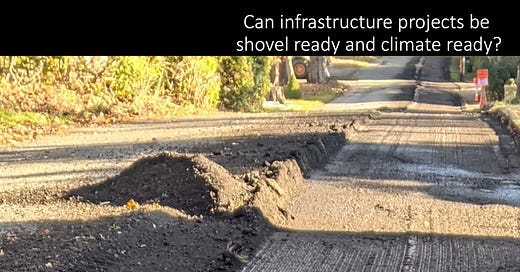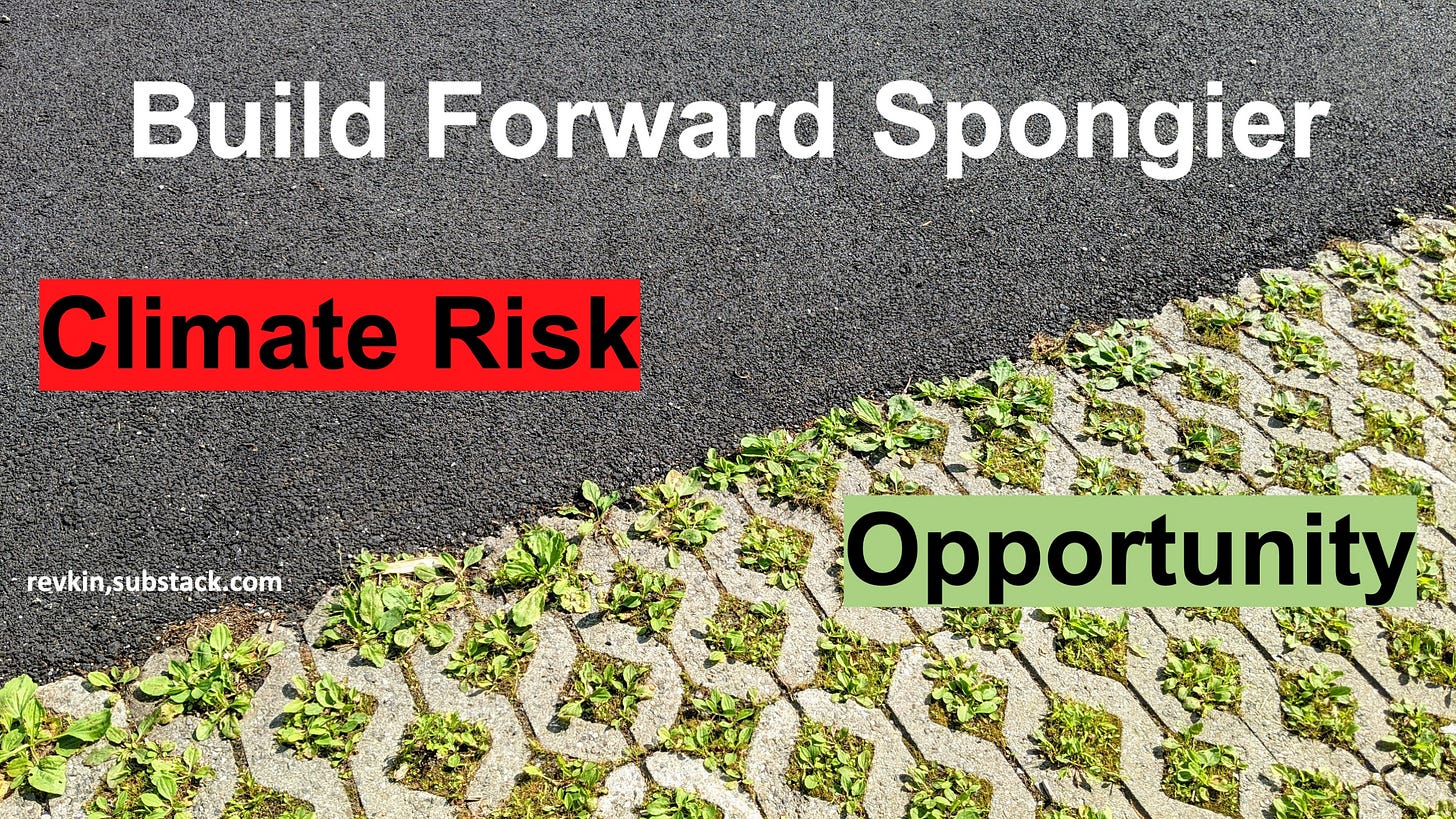To Spend Infrastructure Billions Without Worsening Climate Risk, Unbuild Forward Better, Too
With the massive infrastructure rebuild in high gear, watch out for projects that are shovel-ready but not climate-ready
This pre-Substack post is more important than ever as flood and other disaster losses pile up, including after New York City’s latest deluge from a rare Atlantic Ocean variant of the atmospheric rivers that soaked California earlier this year.
Originally published Nov. 14, 2021 -
The passage of the $1.2 trillion "Bipartisan Infrastructure Deal" in a recent House vote, with the support of 13 Republicans, was an extraordinary achievement aimed at firming up the decaying physical foundations of our economy and communities.
With a Biden signature on Monday, the focus in Washington is now on the end game for the even-bigger Build Back Better Act aimed at restoring frayed social systems, spreading low-carbon energy systems and so much more.
But the focus of every community in America should now also be on figuring out how to spend this historic burst of infrastructure funding, much of which will go to state and local governments, in ways that don't build new risk or miss pockets of deep vulnerability.
I'll focus here on surface transportation and flooding. The bill language calls for the development of "strategies to reduce the climate change impacts of the surface transportation system and a vulnerability assessment to identify opportunities to enhance the resilience of the surface transportation system and ensure the efficient use of federal resources."
Here's hoping this two-pronged requirement is actualized even under intense pressure for shovel-ready, job-generating projects.
Somehow, at all levels, we have to figure out how to do shovel-ready work but also make it climate-ready - meaning future resistant if not future-proofed.
The pressure is already on, signaled by celebratory news releases from business groups. These include the National Asphalt Pavement Association and Portland Cement Association. The biggest component of the deal is $110 billion in new funding over five years for state and local road projects - bringing the total federal spend in that span to $360 billion. That's billion with a B.
That is great for the economy, and for existing roadways, many of which are in deep disrepair. (The banner at the top is long-overdue road work outside my window today here in the Hudson River valley.)
But the deal - deemed "the largest investment in the resilience of physical and natural systems in American history" by the White House - has to work for the long haul, as well.
It's vital to prioritize projects built to withstand what's coming as global warming proceeds (recalling that even aggressive and global cuts in greenhouse gas emissions won't tame weather extremes for decades.)
Below you can read valuable input from some experts on why the investments targeted in this bill could stand the test of time. But let's start with a couple of examples that show what to watch for.
Railroads that work for the long haul
Among a host of initiatives, the deal "will invest $66 billion to provide healthy, sustainable transportation options for millions of Americans by modernizing and expanding transit and rail networks across the country."
Given that infrastructure, by definition, is systems designed to last decades, let's hope there is a firm requirement that rail investments are predicated on track owners committing to multi-decadal plans that take into account rising sea levels and rain-driven flood risk.
Do we really want a rail system that gets hammered and fixed, hammered and fixed, as is the case for the Hudson Line north of New York City - pictured here after the flash floods spawned by the remains of Hurricane Ida?

To get the bigger picture, please click back to "Rising Waters Are Drowning Amtrak’s Northeast Corridor," a sobering piece by Christopher Flavelle and Jeremy C.F. Lin for Bloomberg.
Be wary when one investment can hurt another
It's also vital to check to be sure funded projects in one sector don't undercut work in others.
Consider, as one example, the potential outcomes if communities rush to repave or expand existing roads without regard for existing flood risk, let alone the threat of worse to come in a changing climate.
That Hudson Line rail washout I showed above didn't happen on a random stretch of the Metro North Railroad line. It was where a stream called Wickers Creek runs beneath the tracks - and in this case overtopped the rails. Why is that creek a conduit for so much water? It's not just inches per hour of rain. It's the lack of the watershed's capacity to buffer heavy downpours.
So the resilience of rail systems is also a function of the resilience of surrounding watersheds.
Build forward spongier
China's "sponge cities" are hardly perfect, as recent deadly flooding showed. But that concept is something to normalize as a path to fewer regrets in an era of intensified downpours. Here's a graphic to pass around - not quite a bumper sticker.
That leads to my headline point about "unbuilding" forward better.
In 2009, I began focusing on a series of brilliant and politically challenging efforts to undertake what's called "daylighting" - exposing waterways that generations earlier was paved over or routed through storm drains and giving them space to be rivers or streams again.
This has happened from Seoul, South Korea, to Yonkers, N.Y. The process isn't easy. It took the then-mayor of Seoul dozens of community meetings to convince merchants and property owners to accommodate the the plan to restore the Cheonggyecheon, a stream that marked the historic heart of that now-sprawling city.
But to me, it's essential.
I reached out to a couple of experts who've dug deep on the transportation and "green" side of the Bipartisan Infrastructure Deal.
Forbes Tompkins, manager for federal policy at The Pew Charitable Trusts Flood-Prepared Communities program, sees signs of progress. In the transportation sections, he said, "natural infrastructure" is eligible for funding under a new multi-billion-dollar grant program called PROTECT (Promoting Resilient Operations for Transformative, Efficient and Cost-saving Transportation). Natural solutions are also included in some existing highway programs.
"By incorporating natural infrastructure across new and existing federal programs aimed at repairing, maintaining, and improving the nation’s roadways and bridges, the bill will help communities and states leverage nature when undertaking efforts to address the growing threat of flooding and other disasters," Tompkins said in an email. Click for more from Pew.
Here’s another “sticker” for you.
Yes, the infrastructure deal is historic
The backlog of infrastructure needs is enormous. This deal ends a decades-long bipartisan slumber party on such investments that created deadly, costly vulnerability in critical systems and communities around this nation.
The need for a systems makeover in this country - from rails to roads to dams to power grids to broadband and the rest - couldn't be more urgent for a host of reasons. For physical systems, the warnings have been coming from engineers and scientists for decades and lately have been manifested in hammer blows from the turbulent, increasingly human-jolted climate system.
In one of my Sustain What webcasts earlier this year on extreme flooding, Upmanu Lall, director of the Columbia Water Center, said, "We've been sleeping" since a burst of ambitious infrastructure investment around and after World War 2. "Basically, if you look at the investment in any kind of measures for flood control it's been nonexistent for the last 30 or 40 years," he said. Watch and share the discussion, which is as relevant as ever:
In an email, Lall said the bill is a big step forward, but noted another critical action - being sure this investment goes where it's most needed - to projects benefitting communities that face the deepest vulnerability by dint of poverty or, particularly, racial prejudice. He was mainly addressing water initiatives, but the points should apply to any federal resilience investment:
"There is no mapping of the communities by severity of need (as we are trying to do) and no attempt in the government to do so," Lall said. "There is evidence that the communities most in need typically do not have the resources to even properly apply for federal funding from the E.P.A. programs, and there is evidence that the spending by those programs largely benefits communities that are not the original targets of investment, and that the spending may be high for what is delivered in the process. So, beyond the infrastructure bill and the allocation of funds we have critical delivery issues that are going unaddressed."
Overcoming the climate "tragedy of the horizon"
As a final thought, it's worth widening out to the global scale in pondering investments that cut climatic and society risk for the long haul. I hope you'll find time to click and read a remarkable 2015 speech by Mark Carney, who is currently a special United Nations climate envoy and has long been a leading figure in sustainable investment and banking: "Breaking the tragedy of the horizon – climate change and financial stability."
If we don't get the balance better between the political pressures of now and the physical realities to come, presidents will unavoidably have to continue making the disaster visit a standard part of the work of the commander in chief.
Much of the loss of life as Hurricane Ida's remains disgorged record rainfall bursts over the Northeast occurred in flooded highways and basements inundated where decades of paving and development spread over what had once been waterways.
When Biden toured the flash-flood wreckage in New York and New Jersey in September, the story was the classic recovery and rebuild message. But if we simply repave and rebuild, there'll be more such tragedies anywhere rain falls faster than it can drain.
Insert, Nov. 10, 2021 - Read the new dispatch by my Bulletin colleague Ian Bremmer for welcome detail on why this deal matters so much and what is still needed to overcome a half-century lag in infrastructure investment.
Resources
The Resilient America Program of the National Academies
Thriving Earth Exchange of the American Geophysical Union
2021 Infrastructure Report Card of the American Society of Civil Engineers
Flood Prepared Communities, an excellent program developed by The Pew Charitable Trusts
Global assessment of current and future river flooding and the role of nature-based solutions for risk management, a global report by The Nature Conservancy that is relevant anywhere
Read
Let Water Go Where It Wants to Go, a brilliant New York Times op-ed by the Wildlife Conservation Society ecologist Eric W. Sanderson
Daylighting the Saw Mill River / Efforts to bring back a natural Yonkers waterway are changing the city, by the filmmaker, writer and photographer Nathan Kensinger
Unequal Protection Revisited: Planning for Environmental Justice, Hazard Vulnerability, and Critical Infrastructure in Communities of Color - a comprehensive review of this long-neglected aspect of infrastructure planning, by Marccus D. Hendricks and Shannon Van Zandt
Three Ways to Think Like a Sponge City, posted by the company StormSensor
Watch
After Ida - Paths to Flash Flood Safety - a Sustain What chat on resilience to flooding with Harold Brooks, a senior scientist at the National Severe Storms Laboratory and leading authority on flash flood science, Erica Gies, a reporter and National Geographic Explorer whose upcoming book is "Water Always Wins," and Laura Shepard, a New York City bicycling organizer based in Queens, N.Y., who tweeted relentlessly about the deadly flood impacts there.
Help expand Sustain What
I hope you'll subscribe here and weigh in with a comment or question. I plan to keep content free for all while happily taking contributions from those who can afford it.
Find my social media accounts, books and music in a single click here.
Parting shot
Craig E. Colten of Louisiana State, one of my favorite geographers, took these photos of two houses in Louisiana that vividly illustrate how we can all make choices that cut or worsen risk. Read my Dot Earth post on "How Growth-Focused Politics Helped Build Vulnerability in Louisiana’s Flood Zones" for more.













